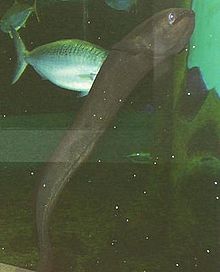Speckled longfin eel
| Speckled longfin eel | |
|---|---|

| |
| Scientific classification | |
| Domain: | Eukaryota |
| Kingdom: | Animalia |
| Phylum: | Chordata |
| Class: | Actinopterygii |
| Order: | Anguilliformes |
| Family: | Anguillidae |
| Genus: | Anguilla |
| Species: | A. reinhardtii
|
| Binomial name | |
| Anguilla reinhardtii Steindachner, 1867
| |
The speckled longfin eel, Australian long-finned eel or marbled eel (Anguilla reinhardtii) is one of 15 species of eel in the family Anguillidae. It has a long snake-like cylindrical body with its dorsal, tail and anal fins joined to form one long fin. The dorsal fin also often extends farther than the anal fin. It usually has a brownish green or olive green back and sides with small darker spots or blotches all over its body. Its underside is paler.[2] It has a small gill opening on each side of its wide head, with thick lips. It is Australia's largest freshwater eel, and the female usually grows much larger than the male.[2][3] It is also known as the spotted eel.
Description
[edit]Long-finned eels can grow to 1.6 metres and 22 kg (although generally to 1 metre) for females while males are much smaller at 650 mm and 600 g.[4] Landlocked eels have been reported to grow to 3 metres (10 feet).[3]
Distribution
[edit]The long-finned eel is a native of New Guinea, eastern Australia (including Tasmania), Lord Howe Island, and New Caledonia.[2] It can be found in many freshwater areas, including creeks, streams, rivers, swamps, dams, lagoons, and lakes although generally more often in rivers than lakes.[3]
Breeding and migration
[edit]Like other Anguilla species, the eel lives predominantly in freshwater rivers and streams, but is born in deep waters of the ocean. Each species has its own spawning grounds; spawn use ocean currents to return to their adult species range. The long-finned eel spawns in the Western arm of the Southern Equatorial Current,[5] which carries spawn to the eastern coast of Australia. This species is panmictic, spawning throughout the year.[6]
Diet
[edit]A carnivorous species, the speckled longfin eel eats an assortment of aquatic vertebrates, such as fish, turtles, and small birds.[7]
References
[edit]- ^ Pike, C.; Crook, V.; Gollock, M. (2019) [errata version of 2019 assessment]. "Anguilla reinhardtii". IUCN Red List of Threatened Species. 2019: e.T196303A154801946. doi:10.2305/IUCN.UK.2019-2.RLTS.T196303A154801946.en. Retrieved 4 August 2023.
- ^ a b c Allen, G.R.; Midgley, S.H.; Allen, M. (2002). Freshwater Fishes of Australia. Perth, Western Australia: Western Australian Museum. p. 64. ISBN 0-7307-5486-3.
- ^ a b c Merrick, J.R.; Schmida, G.E. (1984). Australian Freshwater Fishes, Biology and Management. Sydney: Author. pp. 61–63. ISBN 0-9591908-0-5.
- ^ Robert McDowall, ed. (1996). Freshwater Fishes of South-Eastern Australia (Rev Ed). Sydney: Reed Books. pp. 42–43. ISBN 0-86622-936-1.
- ^ Aoyama, Jun (2009). "Life History and Evolution of Migration in Catodromous Eels (Genus Anguilla)". Aqua-BioScience Monographs. 2: 23. doi:10.5047/absm.2009.00201.0001 (inactive 2024-11-20). S2CID 53319110.
{{cite journal}}: CS1 maint: DOI inactive as of November 2024 (link) - ^ Shen, Kang-Ning; Tzeng, Wann-Nian (2007). "Population Genetic Structure of the Year-Round Spawning Tropical Eel, Anguilla reinhardtii, in Australia". Zoological Studies. 46: 451. CiteSeerX 10.1.1.654.2742.
- ^ "Anguilla reinhardtii". www.jcu.edu.au. 2015-10-19. Retrieved 2023-10-22.
- Froese, Rainer; Pauly, Daniel (eds.). "Anguilla reinhardtii". FishBase. February 2006 version.
- Critters of Calamvale Creek
- Inland Fisheries Service Tasmania Long-finned eel fact sheet
- AUSECO
- Royal Forest and Bird Protection Society

